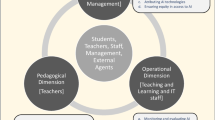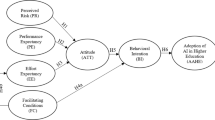Abstract
The rapid advances of information and communication technology (ICT) have transformed teaching and learning in universities. This study therefore sort to establish antecedents of university lecturers’ intention to adopt ICT adoption in Zimbabwean universities. It employed a quantitative approach which used a structured questionnaire on a sample of 600 university lecturers from 6 selected public universities. Descriptive statistics and regression analysis were used for data analysis. Results of the study showed that policy support infrastructure (ICT policy, ICT policy implementation strategy and clear ICT vision), technical support infrastructure (competent support team, ICT tools and systems, internet and reliable power supply) and technical skills infrastructure (training and skills level) acted as antecedents to ICT adoption in Zimbabwean universities. A lack of ICT policy implementation plans and obsolete ICT infrastructure acted as major barriers to ICT adoption. These results have managerial and operational implications for universities to consider for effective adoption of ICT.
Similar content being viewed by others
References
Alaceva, C., & Rusu, L. (2015). Barriers in achieving business/IT alignment in a large Swedish company: What we have learned? Computers in Human Behavior, 51, 715–728.
Altawalbeh, M. A., & Alassaf, H. (2018). Antecedents and consequences of E-learning adoption in Jordanian higher education institution. Advances in Social Sciences Research Journal, 5(5), 378–387.
Andoh, C. (2012). Factors influencing teachers’ adoption and integration of information and communication technology into teaching: A review of the literature. International Journal of Education and Development using Information and Communication Technology, 8(1), 136–155.
Arora, P. (2019). The next billion users: Digital life beyond the west. Cambridge, MA: Harvard University Press.
Ball, D., & Levy, Y. (2008). Emerging educational technology: Assessing the factors that influence instructors’ acceptance in information systems and other classrooms. Journal of Information Systems Education, 19, 431–444.
Baturay, M. H., Gökçearslan, Ş., & Ke, F. (2017). The relationship among pre-service teachers’ computer competence, attitude towards computer-assisted education, and intention of technology acceptance. International Journal of Technology Enhanced Learning, 9(1), 1–13.
Blackwell, C. K., Lauricella, A. R., & Wartella, E. (2014). Factors influencing digital technology use in early childhood education. Computers & Education, 77, 82–90.
Buabeng-Andoh, C. (2012). Factors influencing teachers’ adoption and integration of information and communication technology into teaching: A review of the literature. International Journal of Education and Development using Information and Communication Technology, 8(1), 136–155.
Buchanan, T., Sainter, P., & Saunders, G. (2013). Factors affecting faculty use of learning technologies: Implications for models of technology adoption. Journal of Computing in Higher Education, 25(1), 1–11.
Byungura, J. C., Hansson, H., & Thashmee, K. (2015). User perceptions on relevance of a learning management system: An evaluation of Behavioural intention and usage of SciPro system at University of Rwanda. In T. António Moreira, S. András, & M. Ildikó (Eds.), European distance and E-learning network 2015 annual conference (pp. 582–562). Barcelona, Spain.
Byungura, J.C. (2019). Improving IT integration for higher education institutional performance: Towards a contextualised IT-institutional alignment model. Doctor of Philosophy in Computer and Systems Sciences at Stockholm University.
Comi, S. L., Argentin, G., Gui, M., Origo, F., & Pagani, L. (2017). Is it the way they use it? Teachers, ICT and student achievement. Economics of Education Review, 56, 24–39.
Correos, C. (2014). Teachers ICT literacy and utilization in English language teaching. ICT & Innovations in Education International Electronic Journal, 2(1), 1–25.
Creswell, J. W. (2015). Educational research: Planning, conducting, and evaluating quantitative and qualitative research (5th ed.). Boston, MA: Pearson.
Davide, A., Marianna, G., Massimiliano, M., & Francesco, N. (2018). Backing environmental innovations through information technology adoption. Empirical analysis of innovation related complementarity in firms. Technological and Economic Development of Economy, 24(1), 141–163.
Dellinger, A., Bobbett, J., Olivier, D., & Ellett, C. (2008). Measuring teachers’ self-efficacy beliefs: Development and use of the TEBS-self. Teaching and Teacher Education, 24(3), 751–766.
Dessart, L., Veloutsou, C., & Morgan-Thomas, A. (2015). Consumer engagement in online brand communities: A social media perspective. Journal of Product & Brand Management, 24(1), 28–42.
Eggers, J., & Aseem, K. (2018). Motivation and ability? A behavioral perspective on the pursuit of radical invention in multi-technology incumbents. Academy of Management Journal, 61(1), 67–93.
Gefen, D., & Straub, D. (2005). A practical guide to factorial validity using PLS-graph: Tutorial and annotated example. Communications of the Association for Information Systems, 16, 1–10.
Heeks, R. (2009). The ICT4D 2.0 Manifesto: Where next for ICTs and International Development? Working Paper Series. Manchester: Development Informatics Group http://www.sed.manchester.ac.uk/idpm/research/publications/wp/di/index.htm on 23 April 2020.
Heeks, R. (2014). Development informatics. Working paper series. Paper No. 59. Manchester: Centre for Development Informatics http://www.seed.manchester.ac.uk/subjects/idpm/research/publications/wp/di/ on 23 April 2020.
Heeks, R. (2019). How many platform workers are there in the global South?, ICT4DBlog, 29 Jan https://ict4dblog.wordpress.com/2019/01/29/howmany-platform-workers-are-there-in-the-global-south/.
Heeks, R. (2020). ICT4D 3.0? Part 1 – The components of an emerging “digital for development” paradigm. The Electronic Journal of Information Systems in Developing Countries, 86(3), 1–15.
Higgins, S., & Moseley, D. (2011). Teachers thinking about ICT and learning: Believes and outcomes. Journal of Teacher Development, 5(2), 191–210.
Islam, A. Y. M. A., Mok, M. M. C., Gu, X., Specto, J. M., & Hai-leng, C. (2018). ICT in higher education: An exploration of practices in Malaysian universities. IEEE, 7, 16892–16908.
Jason, L., Yuandi, W., & Lutao, N. (2016). How do dynamic capabilities transform external technologies into firms’ renewed technological resources? A mediation model. Asia Pacific Journal of Management, 33(4), 1009–1036.
John, S. P. (2015). The integration of information technology in higher education: A study of faculty’s attitude towards IT adoption in the teaching process. Contaduría y Administración, 60, 230–252.
Kattoua, T., Al-Lozi, M., & Alrowwad, A. (2016). A review of literature on E-learning systems in higher education. International Journal of Business Management and Economic Research (IJBMER), 7(5), 754–762.
Liu, I.-F., Chen, M. C., Sun, Y. S., Wible, D., & Kuo, C.-H. (2010). Extending the TAM model to explore the factors that affect intention to use an online learning community. Computers & Education, 54(2), 600–610.
Mangin, J.-P. L. (2011). Modeling perceived usefulness on adopting on line banking through the tam model in a Canadian banking environment. Journal of Internet Banking and Commerce, 16(1), 13.
Muianga, X., Byungura, J. C., Hansson, H., Colombage, R. P., & Mutimucuio, I. (2016). Blended learning systems in tertiary education: A comparative analysis of two universities from Rwanda and Mozambique. E-Learn: World Conference on E-Learning in Corporate, Government, Healthcare, and Higher Education (pp. 1006–1015). Washington, DC: Association for the Advancement of Computing in Education (AACE).
Nayak, M. S. D. P., & Narayan, K. A. (2019). Strengths and weakness of online surveys. IOSR Journal Of Humanities And Social Science (IOSR-JHSS), 24(5), 31–38.
Perrotta, C. (2013). Do school-level factors influence the educational benefits of digital technology? A critical analysis of teachers’ perceptions. British Journal of Educational Technology, 44(2), 314–327.
Phua, P. L., Wong, S. L., & Abu, R. (2012). Factors influencing the behavioural intention to use the internet as a teaching-learning tool in home economics. Procedia – Social and Behavioral Sciences, 59(2012), 180–187.
Pontes, H. M., & Griffiths, M. D. (2015). Measuring DSM-5 internet gaming disorder: Development and validation of a short psychometric scale. Computers in Human Behavior, 45, 137–143.
Richardson, J. (2009). Providing ICT skills to teacher trainers in Cambodia: Summary of project outputs and achievements. Journal of Education for International Development, 4(2), 1–12.
Sang, G., Valcke, M., Braak, J., & Tondeur, J. (2010). Student teachers thinking processes and ICT integration: Predictors of prospective teaching behaviors with educational technology. Computers & Education, 54(1), 103–112.
Schoonenboom, J. (2014). Using an adapted, task-level technology acceptance model to explain why instructors in higher education intend to use some learning management system tools more than others. Computers & Education, 71, 247–256.
Seetharaman, P., Cunha, M. A., & Effah, J. (2019). IT for the informal sector in developing countries: A broader perspective. The Electronic Journal of Information Systems in Developing Countries, 85(3), e12093.
Tarus, J. K., Gichoya, D., & Muumbo, A. (2015). Challenges of implementing e-learning in Kenya: A case of Kenyan public universities. The International Review of Research in Open and Distributed Learning, 16(1), 120–141.
Tavakol, M., & Dennick, R. (2011). Are Asian international medical students just rote learners? Theory and Practice, 15(3), 369–377.
Teeroovengadum, V., Heeraman, N., & Jugurnath, B. (2017). Examining the antecedents of ICT adoption in education using an extended technology acceptance model (TAM). International Journal of Education and Development using Information and Communication Technology (IJEDICT), 13(3), 4–23.
Thatcher, J. B., & Perrewé, P. L. (2012). An empirical examination of individual traits as antecedents to computer anxiety and computer self-efficacy. MIS Quarterly, 26(4), 381–396.
The Research Advisors. (2006). Sample size table. Retrieved from http://research-advisors.com/index.php on 23 March 2020.
Tondeur, J., Aesaert, K., Pynoo, B., Braak, J., Fraeyman, N., & Erstad, O. (2017). Developing a validated instrument to measure preservice teachers’ ICT competencies: Meeting the demands of the 21st century. British Journal of Educational Technology, 48(2), 462–472.
Valentinin, F., & Damasio, B. F. (2016). Artigos Originais Variância Média Extraída e Confiabilidade Composta: Indicadores de Precisão. Psicologia: Teoria e Pesquisa, 32(2), 1–7.
Wang, Y., Han, X., & Yang, J. (2015). Revisiting the blended learning literature: Using a complex adaptive systems. Educational Technology & Society, 18(2), 380–393.
Acknowledgements
The researcher wishes to acknowledge all lecturers in the participating universities for making this study possible.
Authors’ contributions section
The author is the sole contributor to this study.
Funding
No funding sources to declare in this study.
Author information
Authors and Affiliations
Corresponding author
Ethics declarations
Competing interests section
The author has no competing interests to declare in this study.
Additional information
Publisher’s note
Springer Nature remains neutral with regard to jurisdictional claims in published maps and institutional affiliations.
Rights and permissions
About this article
Cite this article
Rudhumbu, N. Antecedents of university lecturers’ intentions to adopt information and communication technology in Zimbabwe. Educ Inf Technol 25, 5117–5132 (2020). https://doi.org/10.1007/s10639-020-10205-4
Received:
Accepted:
Published:
Issue Date:
DOI: https://doi.org/10.1007/s10639-020-10205-4




